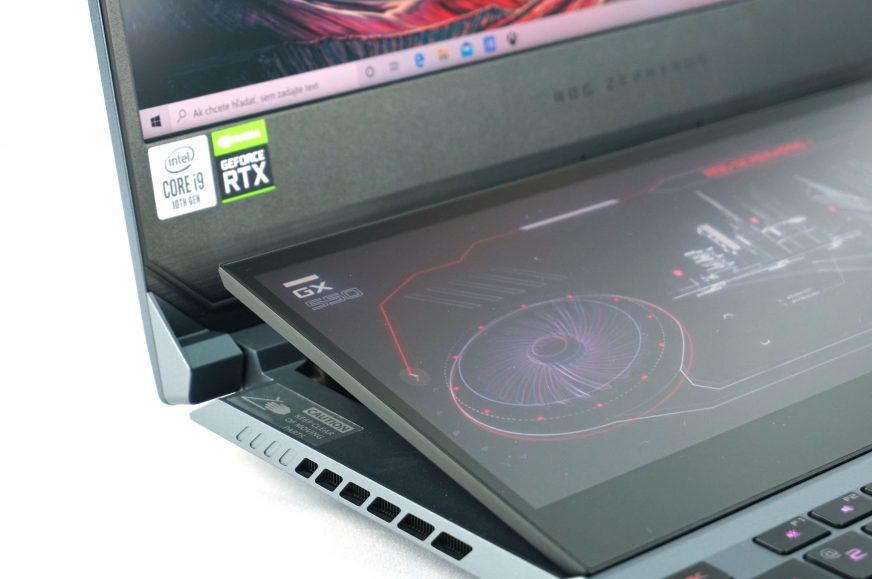Rendering and Geekbench
Asus ROG Zephyrus is a premium line of gaming laptops that merges maximum performance with unique design and functional solutions. The hallmark has always been the AAS which stands for cooling with a flexible portion of the bottom that would uplift the notebook a few mm. On the other side of the portfolio there are ZenBooks, where Pro Duo with two displays attracted our interest last year. A new flagship, that merges the best that the manufacturer can offer, is here.
Rendering and Geekbench
Zephyrus Duo 15 comes with the strongest mobile Intel Core i9-10980HK. It is the direct successor of the last generation 9980HK, which we saw in ROG Mothership, for example, and the slightly weaker equivalent of 9880H, for example from the HP Omen X 2S, is also not very far behind on paper. Until recently, 8 cores were the pinnacle of mobile processors, but as you know, AMD with the Ryzen 4000 Renoir eight-core in laptops also brought it to lower price categories, and especially the Zephyrus G14 with 4900HS gave great test results. So it will be interesting to see if Intel was able to squeeze out anything more from the Skylake architecture, as they did in the tenth-generation desktops.
Let’s start with the traditional Cinebench R15 for a first look at the raw performance of the processor. The new i9 in Zephyrus holds a 10-13% lead in the single-core from the previous generation in the HP Omen X 2S or MSI GS75 Stealth. Also from 4900HS in Zephyrus G14. This being said, it matched the desktop 8700K. This is the highest single-core performance in a laptop, not counting ROG Mothership, which is a concept device that is not sold normally. In multi-core, the new i9 has an 11% lead over Renoir and 30-40% over 9th generation Intel. This is a really solid increase in performance.
The newer R20 already shows smaller differences in single-core compared to Renoir processors. The 4900HS is only 4% slower. In contrast, Intel is still 12-13% slower. Worth mentioning is the ultrabook Acer Swift 3 with 4700U, which loses only 3% to the top i9. In multi-core, Zephyrus is 7% faster than a sibling with AMD and up to 37% faster than HP with the last generation i9. So it looks like Intel in the 10th generation pushed out quite significant performance increases from the same architecture.
Practical tests of Cinebench and POV-Ray show the real power of Zephyrus and the new i9. In Blender, the i9 is 19% faster than 4900HS in G14 and up to 25% faster than the previous i9 in HP. POV-Ray surprisingly has only a 5% lead over the G14 with Renoir but HP with the old i9 is up to 30% slower.
Geekbench in 3 versions again gives a little hint at the differences between the individual processors in laptops. We compare Zephyrus Duo 15 with G14 and Omen X 2S. Against a sibling with AMD, the novelty with i9 has a balance of -1/14/10% in single-core and 10/21/11% in multi-core. So, overall it is stronger, but don’t forget that the 4900HS is a 35W processor and we’re comparing it to 45W. The comparison with HP and the previous i9 is 5/6/10% in single-core in favor of the new Zephyrus and 12/8/12% in multi-core, again in favor of the novelty.
In Compute, we compare the performance of the 2080 Max-Q in HP and the newer 2080 Super Max-Q in Zephyrus. Geekbench 4 is practically identical, with a 2% loss for Zephyrus which, however, can be attributed to measurement errors. On the contrary, the newer Geekbench 5 already shows 20% higher performance of the newer Super model.
- Contents
- Parameters and details
- ROG ScreenPad Plus
- Testing methodology
- Rendering and Geekbench
- 3D/PC Mark and Unigine Heaven/Superposition
- Game tests – dedicated graphics
- End of part 1











